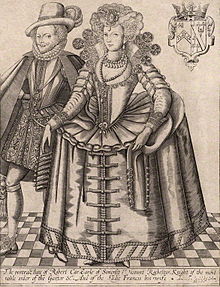The Masque of Flowers



The Masque of Flowers was an entertainment on 6 January 1614 to celebrate the marriage of Robert Carr, 1st Earl of Somerset and Frances Howard, Countess of Somerset.[2]
Masque for a wedding
[edit]The masque was performed by the gentlemen of Gray's Inn at the Banqueting House at Whitehall Palace.[3] Francis Bacon gave £2000 towards the expenses, refusing an offer of £500 from Henry Yelverton so that he would pay the whole charge and have the honour.[4] Courtiers called it "Mr Attorney's Masque".[5] Bacon owed his promotion to Attorney General to Somerset.[6] Flowers was the last of a number of entertainments, including Thomas Campion's The Somerset Masque, Ben Jonson's A Challenge at Tilt and The Irish Masque at Court, and Thomas Middleton's lost Masque of Cupids.[7][8]
The author is unknown. The masque was published with a dedication to Francis Bacon. The music is attributed to John Coprario and John Wilson. James VI and I, Anne of Denmark, and Prince Charles attended and afterwards held a banquet with the performers.[9]
The theme has the Sun devise a contest between Winter "Invierno" and Spring "Primavera". That wine was more worthy than tobacco was debated. Men transformed to flowers would be men again.[10]
Silenus, companion of Dionysus the ancient god of wine, entered riding an artificial ass. "Kawasha" dressed with tobacco leaves was carried into the hall by two actors dressed as the inhabitants of Florida, followed by his sergeant carrying a tobacco pipe as big as a caliver rifle. Thirteen masque dancers represented flowers.[11]
Kawasha was the name of a Native American god of tobacco in Virginia, according to Thomas Harriot.[12][13] Samuel Purchas described the worship of "Kiwasa" in Florida.[14] The wedding entertainments reference colonial enterprise because the bride's father, Thomas Howard, 1st Earl of Suffolk, was an investor.[15]
Flower costumes
[edit]According to the 1614 publication, the flower dancers were "apparelled in doublets and round hose of white satin; long white silk stockings; white satin pumps; the doublet richly embroidered in curious panes with embossed flowers of silver, the panes bordered with embroidery of carnation silk and silver; the hose cut in panes answerable to the embroidery of the doublets; the skirts of the doublets embroidered and cut into lily-flowers, and the wings set forth with flowers of several colours, made in silk and frosted with silver; ruff-bands edged with a lace of carnation silk and silver, spangled very thick, and stuck full of flowers of several kinds; fair vizards and tresses; delicate caps of silk and silver flowers of sundry kinds, with plumes of the same, in the top whereof stuck a great bunch of egrets; every Masker's pump fastened with a flower suitable to his cap; on their left arms a white scarf fairly embroidered sent them by the Bride, and on their hands a rich pair of embroidered gloves, sent them by the Bridegroom".[16]
Bacon, probably informed by his experience funding The Masque of Flowers,[17] wrote: "colours that show best by candlelight are white, carnation, and a kind of sea-water green; and oes and spangs as they are of no great cost, so they are of most glory. As for rich embroidery it is lost and not discerned". Sea green costume was used in the masques of Anne of Denmark and also appears in her wardrobe inventory.[18][19]
References
[edit]- ^ Tristan Marshall, Theatre and empire: Great Britain on the London stages under James VI and I (Manchester, 2000).
- ^ Christine Adams, 'Francis Bacon's Wedding Gift of A Garden of a Glorious and Strange Beauty for the Earl and Countess of Somerset', Garden History, 36:1 (Spring 2008), p. 45.
- ^ John Nichols, Progresses of the James the First (London, 1828), p. 734.
- ^ Martin Butler, The Stuart Court Masque and Political Culture (Cambridge, 2008), pp. 8, 77, 214: Norman Egbert McClure, Letters of John Chamberlain, vol. 1 (Philadelphia, 1939), p. 493.
- ^ Norman Egbert McClure, Letters of John Chamberlain, vol. 1 (Philadelphia, 1939), p. 499.
- ^ David Lindley, The Trials of Frances Howard: Fact and Fiction at the Court of King James (Routledge, 2013), p. 130: Roger Lockyer, Buckingham (London: Longman, 1981), p. 214.
- ^ David Lindley, Embarrassing Ben: The Masques For Frances Howard, English Literary Renaissance, 16:2 (Spring 1986), pp. 347–48: Norman Egbert McClure, Letters of John Chamberlain, vol. 1 (Philadelphia, 1939), pp. 495–98.
- ^ Masque of Cupids, Lost Plays Database
- ^ John Nichols, Progresses of the James the First (London, 1828), p. 745.
- ^ Martin Butler, The Stuart Court Masque and Political Culture (Cambridge, 2008), pp. 71, 216.
- ^ John Nichols, Progresses of the James the First (London, 1828), pp. 734–745.
- ^ Edward McLean Test, Sacred Seeds: New World Plants in Early Modern English Literature (University of Nebraska, 2019), p. 60.
- ^ Lauren Working, The Making of an Imperial Polity: Civility and America in the Jacobean Metropolis (Cambridge, 2020), p. 189. doi:10.1017/9781108625227
- ^ E. A. J. Honigmann, 'The Masque of Flowers', Gerald Eades Bentley, A Book of Masques: In Honour of Allardyce Nicoll (Cambridge, 1967), p. 154.
- ^ Rebecca Ann Bach, Colonial Transformations: The Cultural Production of the New Atlantic World (Palgrave, 2000), p. 178.
- ^ John Nichols, Progresses of the James the First (London, 1828), pp. 743–744 modernised here.
- ^ Lesley Mickel, 'Glorious Spangs and Rich Embroidery: Costume in The Masque of Blackness and Hymeniae', Studies in the Literary Imagination, 36 (2003), p. 46.
- ^ Samuel Harvey Reynolds, Essays: Or, Counsels, Civil and Moral of Francis Bacon (Oxford 1890), p. 270: Andrea Stuart, 'Court Masques: Tableaux of Modernity in the Early Seventeenth Century?', Christopher Breward, Caroline Evans, Caroline Edwards, Fashion and Modernity (Berg, 2005), p. 91: Maria Hayward, Stuart Style (Yale, 2020), p. 73: Jemma Field, 'The Wardrobe Goods of Anna of Denmark, Queen Consort of Scotland and England (1574–1619)', 51:1 Costume (March 2017), p. 16.
- ^ Jane Ashelford, Dress in the Age of Elizabeth I (Batsford, 1988), p. 126.
